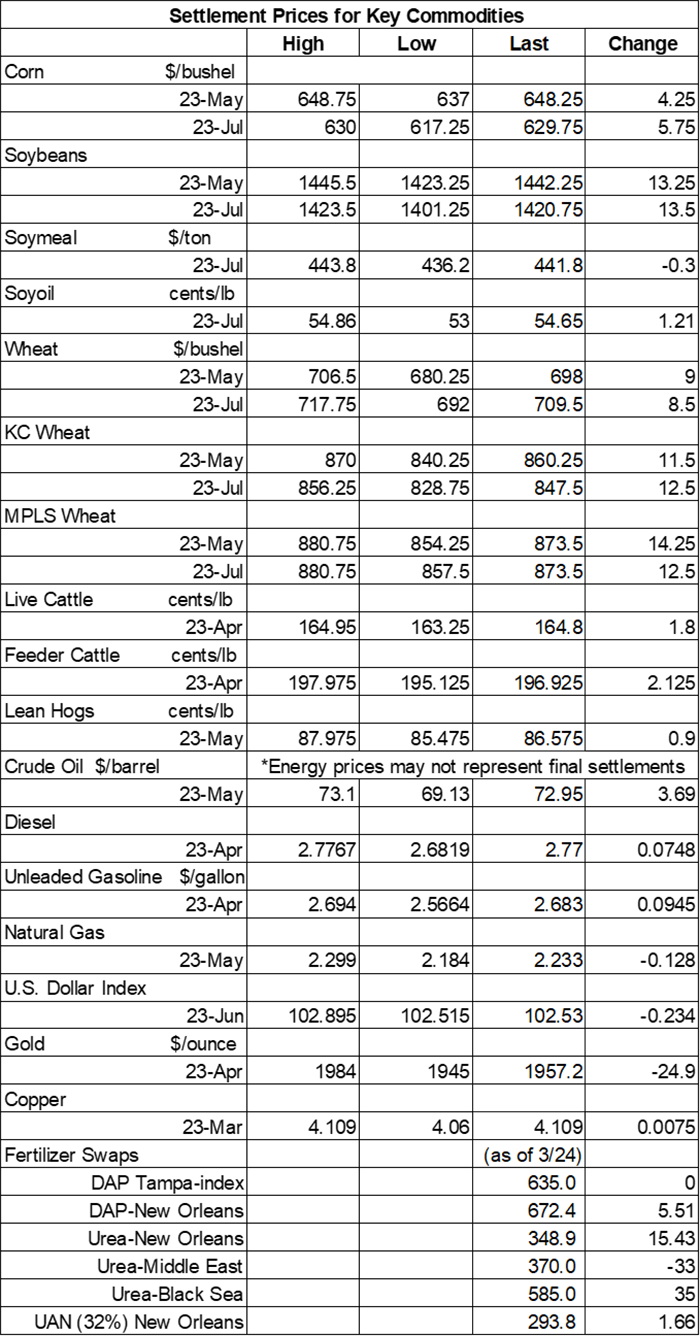Slow Brazilian harvest lifts soybean prices
Afternoon report: Corn and wheat prices also in the green to start the week.
March 27, 2023

Soaring energy futures and solid gains on Wall St. fueled enough spillover support to trigger a round of technical buying that lifted all grain prices on Monday. Corn and soybean prices each firmed nearly 1% higher. Most wheat contracts found double-digit improvements, meantime, with some closing nearly 1.75% higher today.
Large portions of the Corn Belt will remain completely dry between Tuesday and Friday, although parts of the Northern Plains, upper Midwest and Great Lakes region will see at least some measurable rain and/or snow during that time, per the latest 72-hour cumulative precipitation map from NOAA. The agency’s new 8-to-14-day outlook predicts a return to seasonally wet weather for most of the central U.S. between April 3 and April 9, with colder-than-normal conditions likely for the northern U.S. next week.
On Wall St., the Dow rose 285 points in afternoon trading to 32,522 as the banking sector continues to make improvements after the SVB scare from earlier this month. Energy futures climbed significantly higher, with crude oil up more than 5% this afternoon to $73 per barrel on some export stoppages coming from Iraq and Turkey. Diesel rose 3%, with gasoline up around 4%. The U.S. Dollar softened moderately.
Last Friday, commodity funds were net buyers of all major grain contracts, including corn (+7,500), soybeans (+4,500), soymeal (+4,000), soyoil (+5,000) and CBOT wheat (+12,000).
Corn
Corn prices continued to rise on Monday thanks to another flash sale announced this morning. And while USDA’s latest set of export inspection data failed to impress, spillover strength from a broad set of other commodities was enough to trigger a round of technical buying. May futures added 4.25 cents to $6.4725, with July futures up 5.75 cents to $6.2875.
Corn basis bids were steady to weak across the central U.S. on Monday after spilling 2 to 12 cents lower at four Midwestern locations today.
Private exporters announced the sale of 4.4 million bushels of corn for delivery to unknown destinations during the 2022/23 marketing year, which begins September 1.
Corn export inspections tumbled well below the prior week’s total to 26.2 million bushels in the week through March 23. That was also below the entire range of analyst estimates, which came in between 27.6 million and 55.1 million bushels. Mexico was the No. 1 destination, with 10.3 million bushels. Cumulative totals for the 2022/23 marketing year remain well below last year’s pace so far, with 716.3 million bushels since the beginning of September.
Brazil’s AgRural reports that the country’s 2023 center-south second corn crop planting progress has reached 96% through March 23. All of the second corn crop had been planted by this time last year.
All eyes will be on USDA’s highly anticipated Prospective Plantings report this Friday. But don’t sleep on “that other report” that will be released simultaneously, according to grain market analyst Bryce Knorr. “A friendly quarterly Grain Stocks print would be especially welcomed after sixth months of sluggish markets,” Knorr notes. “Soybeans locked up in on-farm storage at harvest may have netted a few pennies after costs for interest and handling. But corn put in the bin, on average, is in the red.” Click here to catch up on Knorr’s latest round of analysis.
Preliminary volume estimates were for 295,711 contracts, eroding moderately below Friday’s final count of 359,910.
Soybeans
Soybean prices trended nearly 1% higher on a round of technical buying spurred by a slower-than-normal Brazilian harvest, with spillover strength from a broad set of other commodities lending additional support. May futures rose 13.25 cents to $14.4150, with July futures up 13.5 cents to $14.1975.
The rest of the soy complex was also firm. Soyoil futures jumped 2.25% higher, while soymeal only managed to gather fractional gains.
Soybean basis bids were largely steady across the central U.S. to start the week but did trend 3 cents higher at an Ohio elevator and 2 cents higher at an Iowa river terminal on Monday.
Soybean export inspections moved moderately above the prior week’s total to 32.7 million bushels. That was on the very high end of analyst estimates, which ranged between 9.2 million and 33.1 million bushels. China was the No. 1 destination, with 18.6 million bushels. Cumulative totals for the 2022/23 marketing year are still slightly above last year’s pace so far, with 1.652 billion bushels.
Brazilian consultancy AgRural reported today that the country’s 2022/23 soybean harvest is 70% complete through March 23, up eight points from the prior week. That’s moderately below last year’s pace of 75% so far.
Some days, it seems like technology is arriving on the farm with relentless speed. But Darren Frye, CEO of Water Street Solutions, has noticed some common threads that bind the operations that seem to handle all the new things coming at them very well. For starters, they place a high value on lifelong learning. They also encourage each individual on the operation to develop their own individual skill sets. Click here for additional thoughts on keeping up with technology.
Preliminary volume estimates were for 177,917 contracts, spilling moderately below Friday’s final count of 283,880.
Wheat
Wheat prices saw most contracts up by double digits following a round of technical buying largely spurred by spillover strength from other commodities. Uneasiness over whether a current Black Sea shipping deal will continue to get extended added to the bullish sentiment today. May Chicago SRW futures added 9 cents to $6.9750, May Kansas City HRW futures rose 11.5 cents to $8.5950, and May MGEX spring wheat futures climbed 14.25 cents to $8.7175.
Wheat export inspections moved slightly above the prior week’s total, reaching 14.4 million bushels. That was also toward the higher end of trade estimates, which ranged between 7.3 million and 16.5 million bushels. Mexico was the No. 1 destination, with 3.2 million bushels. Cumulative totals for the 2022/23 marketing year remain slightly below last year’s pace, with 612.9 million bushels.
Russian consultancy Sovecon estimates that the country’s wheat exports in March will reach 158.0 million bushels. That would be a monthly climb of 48% and the best turnout since last November, if realized. Russia is the world’s No. 1 wheat exporter.
Preliminary volume estimates were for 97,241 CBOT contracts, which was significantly below Friday’s final count of 196,883.

You May Also Like



